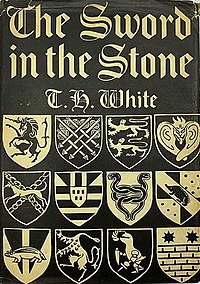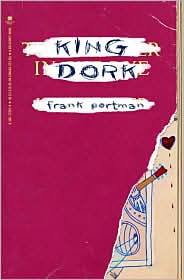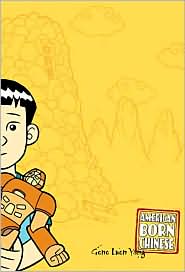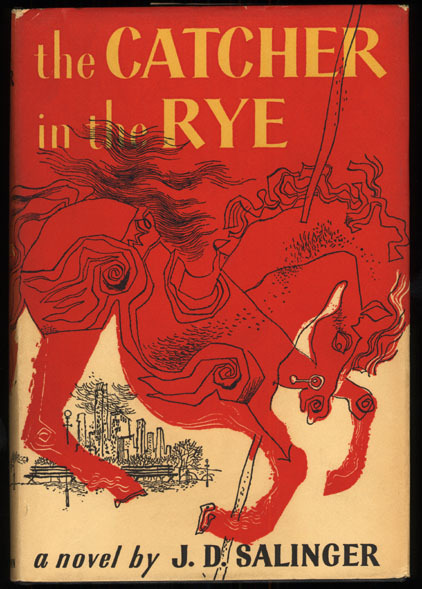
Loner, loser, weirdo, geek. The stereotypical dork is so ingrained in our social conscience that we have no trouble conjuring up a mental image. Computer geek, chess club nerd, wimpy know-it-all—what you see is an awkward teenage boy. Whether we’re boys or girls or men or women, there’s a dorky boy inside each and every one of us. But as these books show, that dork is actually the coolest thing we’ve got going on. The nerdy low-life shows up the popular jock. The smart guy saves the day. The geek gets the girl. The dorky boy is actually cooler, smarter, and funnier than everyone else and once we admit that we love rooting for him, the dorky boy will triumph time and time again.
The Sword in the Stone by T.H. White, 1993, Penguin Books, originally published 1938 (Children's Fiction/ Fantasy Classics)

King Arthur--the most legendary king in history--was once a big dork. At least, that's the way author T.H. White imagined things. Most of our knowledge about King Arthur comes from Le Morte D'Arthur, written by Sir Thomas Malory way back in the fifteenth century. But Malory never wrote about Arthur's childhood and so White took the opportunity to imagine an orphan boy known as the Wart, a scrawny, scrappy kid who needs all the help he can get, especially as he lives in a long-ago England that's run amok with dragons and giants and ever-questing knights. Luckily Wart has Merlyn, a rather bumbling old fellow who nevertheless knows the future and is therefore the ideal tutor for the future king. Merlyn has some unusual methods of instruction, including turning the boy into bird, beast or bug so he can really get a feel for how the world turns. Merlyn talks in anachronisms galore and Wart speaks in good old-fashioned schoolboy slang because to T.H. White and his readers, the glories of the legendary past don't have to remain there. White wrote other novels about the Arthurian legend; his books are combined in The Once and Future King. But The Sword in the Stone remains the classic of the bunch: the smart, sweet, light-hearted story of a small boy and what he has to learn before he has to go out and fulfill his destiny.
The Catcher in the Rye by J.D. Salinger, 2001, Little, Brown and Co., originally published 1951 (Fiction Classics/ Teen Fiction)
Holden Caulfield has become the adolescent voice of every generation since The Catcher in the Rye was published in 1951. Holden's an angst-filled teenager who has just been kicked out of yet another prep school. To vent his confusion and disillusionment, he runs off for a wild weekend in New York City. He desperately wants to be a grown-up--he checks into a hotel room, gets a drink at a club, goes on a date with a girl--but he’s only sixteen years old, and he can’t resist sneaking home to visit his kid sister. Holden is not always the most likeable of heroes (or even the most likeable of anti-heroes). Cynical, wishy-washy, lonesome, and angry, his flaws--and his instistance on calling people out and questioning what they really mean--make him real. He’s in the midst of the same emotion-loaded adolescence that we all can remember and relate to, and that's why Holden's story has remained so immediate, despite the fact that it's also a portrait of upper-class New York society in the 1950s. But Holden, with his slangy narrative voice and his wryly acute observations, rings true even in the twenty-first century, and he's the one teenager who's sure to outlast us all.
King Dork by Frank Portman, 2006, Delacorte Press (Teen Fiction)

Tom Henderson has read The Catcher in the Rye for practically every English class of his high school career. But he's lost his book, and when the classic is assigned again he digs out his deceased father’s old copy. Then he makes an interesting discovery: what seems to be a secret code is scribbled in the margins in his dad's handwriting. Suddenly a commonplace book might just be able to end the cycle of humiliation and suffering that is Tom’s life as the king dork of Hillmont High. As intriguing as the mystery of the beat-up copy of The Catcher in the Rye is, it is Tom’s unique character that makes King Dork stand out. From his hilarious hobby of making up band names and album titles (even though he doesn’t play an instrument) to his self-deprecating wit, Tom is an engaging and likeable teen voice. With Tom leading the way through a story that’s chock full of sex, drugs, and rock-n-roll, King Dork will appeal to the wannabe teenager rebel in all of us.
The Absolutely True Diary of a Part-Time Indian by Sherman Alexie, 2007, Little, Brown and Co. (Teen Fiction/ Illustrated Novel)

It’s tough being a handicapped bookworm who gets beat up at school every day and goes home to a poverty-stricken family on the Spokane Indian Reservation. But fourteen-year-old Junior makes it work with a sarcastic sense of humor and a penchant for drawing some very witty cartoons. Having a bear of a best friend like Rowdy who’s willing to come to your defense doesn’t hurt, either. But Junior is smart, talented, and he wants more. So he enrolls at the town school twenty miles away, where the only other Indian is the team mascot. Dodging and defying stereotypes at every turn, Junior finds himself with unexpected friends and enemies on both sides of the reservation border. Author Sherman Alexie—who, like his dorky hero, is a Spokane Indian born and raised on a reservation—pulls no punches when confronting issues of race and class. But Junior is a wishful, hopeful kid determined to find and hold his place in as many tribes and communities as it takes. Junior’s cartoons (by Ellen Forney) add visual flair and dark humor to a coming-of-age story (and National Book Award winner) that is certain to provoke thought and laughter in equal measure.
American Born Chinese by Gene Luen Yang, 2006, First Second Books (Teen Fiction/ Graphic Novels)

American Born Chinese is a graphic novel that tells its story through comic book-like panels of images and dialogue. It’s a perfect style for a coming-of-age story about a Chinese American boy dealing with the casual racism of high school life, a mythical character from Chinese folklore who thinks the gods don’t respect him because he’s a monkey, and a European American boy suffering the embarrassment of a visit from his Chinese cousin Chin-Kee. These three stories intertwine and merge beautifully through Yang’s lively illustrations and challenging stereotypes. The three characters represent archetypes that we're all familiar with, but they are given realistic flaws and attitudes and their stories are told with originality and spirit—and some surprising plot twists and turns. The tale of Jin, the Monkey King, and Danny is a story for every dorky boy who wishes he was someone else—and let’s face it, we’ve all been there. American Born Chinese is truly an American tale for the American dork in all its forms.
Holes by Louis Sachar, 1998, Farrar, Straus and Giroux (Children's Fiction/ Teen Fiction)

Stanley Yelnats has inherited his curse of bad luck from generations of Yelnats who came before him. A perpetually down-on-his-luck kid even on a good day, Stanley is really in for it now. Wrongfully convicted of stealing a baseball star’s sneakers, Stanley is sentenced to a six-month stint at Camp Green Lake, a juvenile detention camp for wayward boys. But there is no lake at Camp Green Lake. Instead there’s the Warden, a fearsome female who forces the boys to dig holes, five feet wide and five feet deep, in the ground where the lake used to be. When one of the other inmates, a boy named Zero, finally decides he’s had enough and runs off into the Texas desert, Stanley rises to the occasion for the first time in his life and sets off to help. Along the way, the boys uncover the mysteries of Camp Green Lake—mysteries that include old-time Western bandits, Stanley’s pig-stealing great-great-grandfather, and buried treasure. Using cleverly-timed flashbacks and a wide array of quirky characters, author Louis Sachar unfolds this delightful tall tale that celebrates the plight of the underdog. With good guys and villains galore and a dorky boy to cheer for, Holes is a good old-fashioned adventure story.
The Outsiders by S.E. Hinton, 2006, Puffin Books, originally published 1967 (Teen Fiction)

The Outsiders is a story of social divides in the classic vein of Romeo and Juliet and West Side Story. Fourteen-year-old Ponyboy Curtis and his brothers Darry and Sodapop are “Greasers” living on the wrong side of the tracks in their small class-conscious town. They are the perpetual enemies of the rich kids, the socials or “Socs,” who live to rumble with the Greasers. Ponyboy is proud to be a Greaser. He knows that his brothers and their friends may not be perfect, but they will always have his back. But Ponyboy is also curious about the Socs, who, he suspects, might not be all bad. Then fellow Greaser Johnny gets into too much trouble with the Socs, and everything Ponyboy knows is about to change. Ponyboy narrates his tale with honesty and acute observation; his story inspires instant sympathy with the rough but loveable greasers. Every teen who’s been a member of a high school clique--or an outcast--will identify with Ponyboy’s story. The Outsiders was also made into a movie in the 1980s that starred members of the Hollywood brat pack —Patrick Swayze, Matt Dillon, Rob Lowe, C. Thomas Howell, Emilio Estevez, Tom Cruise—and the book and movie make ideal companions. S.E. Hinton wrote the book when she was only sixteen years old; The Outsiders speaks with a genuine teen voice. This classic of teen literature is not to be missed—even if (or maybe especially if) you’re not a teen anymore.

No comments:
Post a Comment